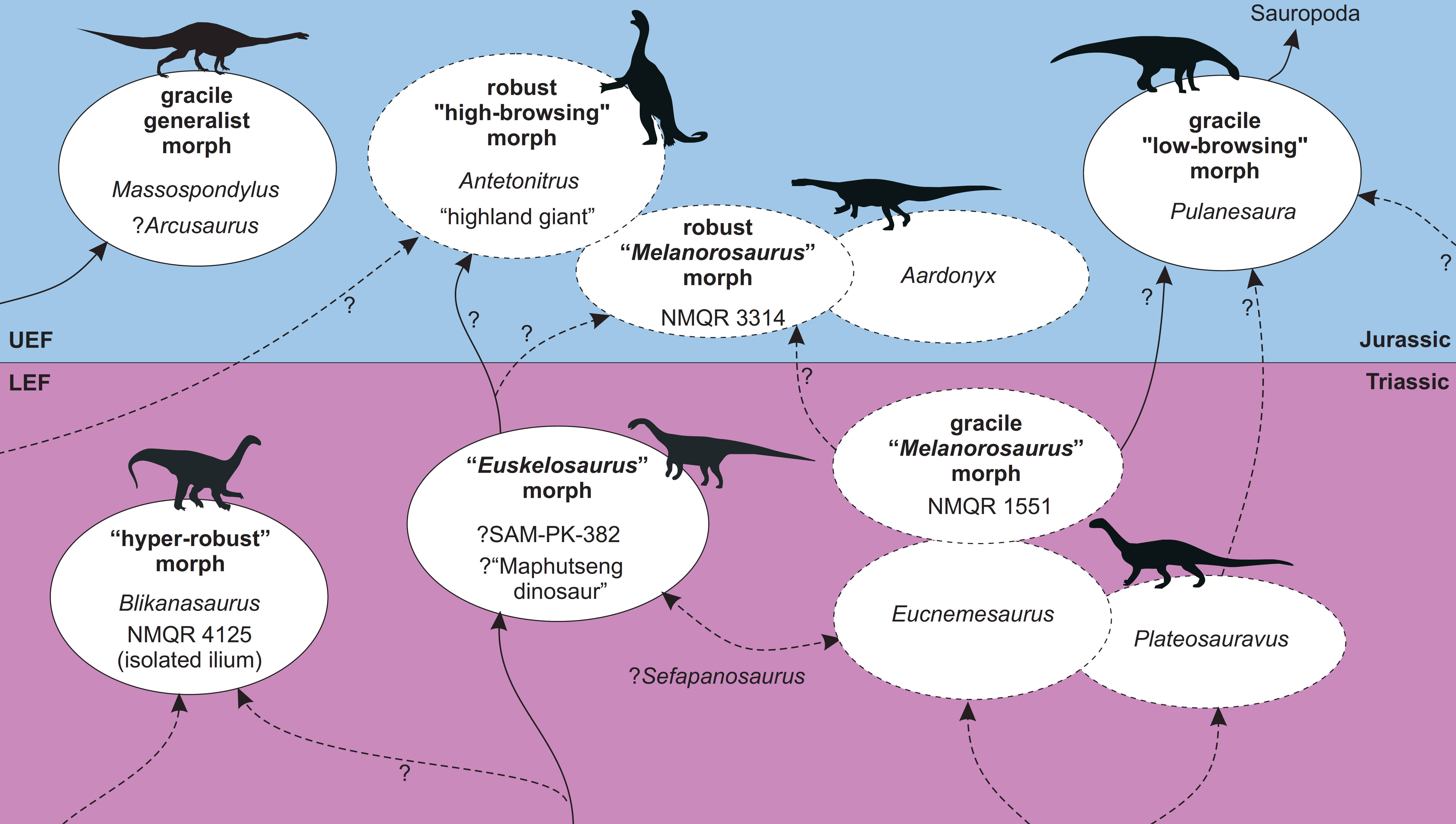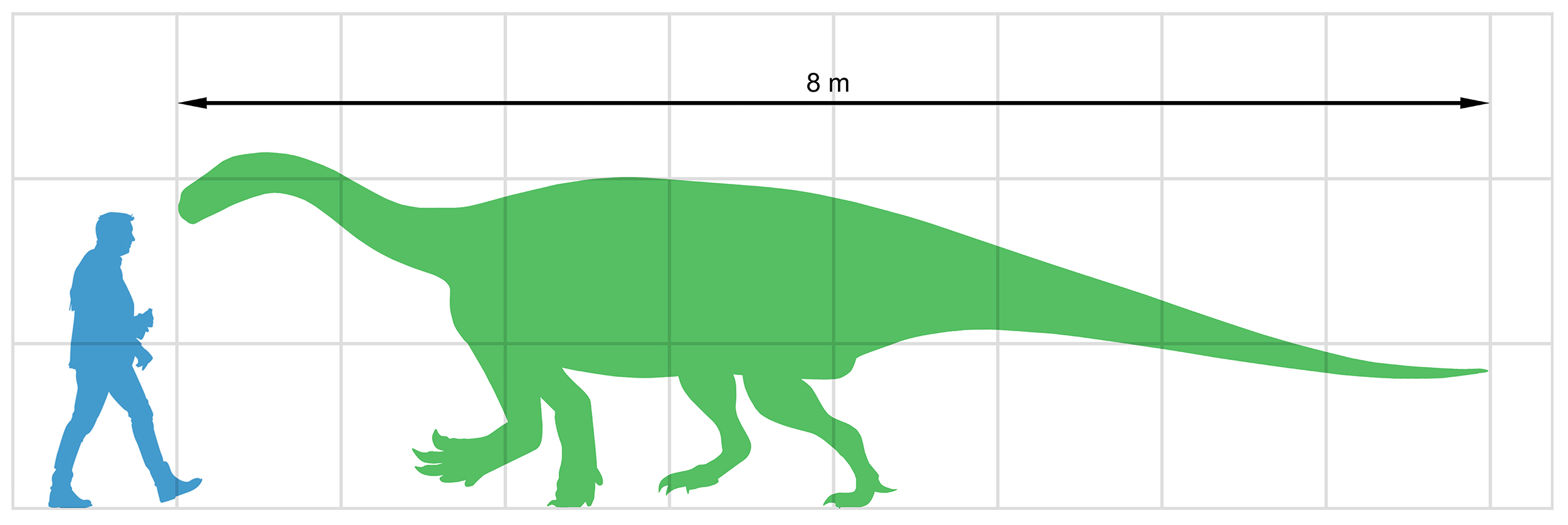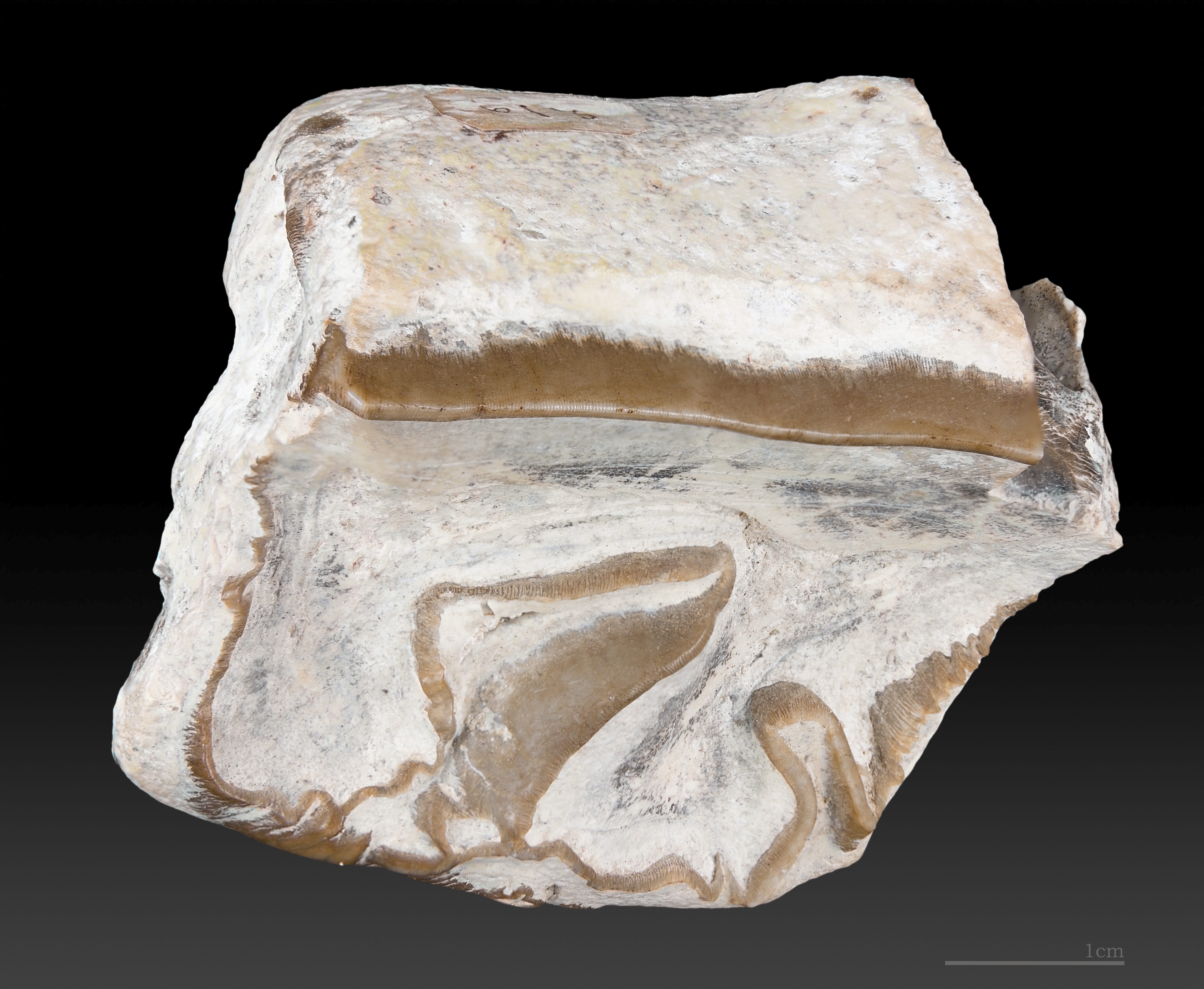|
Kholumolumo
''Kholumolumo'' (referring to a type of dragon the local Basuto associate with dinosaurs), formerly "Kholumolumosaurus" or "Thotobolosaurus", is an extinct genus of massopodan sauropodomorph dinosaur, which was closely related to '' Sarahsaurus'', from the lower Elliot Formation of Maphutseng, Lesotho. The type species, ''Kholumolumo ellenbergerorum'' was formally described in 2020. Discovery and naming In 1930, Samuel Motsoane, principal of the Paris Evangelical Mission School at Bethesda in Lesotho, found dispersed dinosaur bones. In 1955, he told this to the protestant missionary Paul Ellenberger. In September 1955, P. Ellenberger and his brother François Ellenberger uncovered a bonebed in the immediate vicinity of a refuse pile a few meters from native huts in the Village of Maphutseng, western Lesotho, in a layer of the Elliot Formation. The location was locally called the ''Thotobolo ea ‘Ma-Beata'', the "trash heap of Beata's mother". In November 1955, they were re ... [...More Info...] [...Related Items...] OR: [Wikipedia] [Google] [Baidu] |
Massopoda
Massopoda is a clade of sauropodomorph dinosaurs which lived during the Late Triassic to Late Cretaceous epochs. It was named by paleontologist Adam M. Yates of the University of the Witwatersrand in 2007. Massopoda is a stem-based taxon, defined as all animals more closely related to ''Saltasaurus loricatus'' than to ''Plateosaurus engelhardti''. The name Massopoda, ; , is also contraction of Massospondylidae and Sauropoda, two disparate taxa in the clade. Classification Yates assigned the Massopoda to Plateosauria. Within the clade, he assigned the families Massospondylidae (which includes the relatively well-known dinosaur ''Massospondylus'') and Riojasauridae (which includes ''Riojasaurus'') as well as the Sauropoda. The following is a cladogram A cladogram (from Greek ''clados'' "branch" and ''gramma'' "character") is a diagram used in cladistics to show relations among organisms. A cladogram is not, however, an evolutionary tree because it does not show how ancestors ... [...More Info...] [...Related Items...] OR: [Wikipedia] [Google] [Baidu] |
Elliot Formation
The Elliot Formation is a geological formation and forms part of the Stormberg Group, the uppermost geological group that comprises the greater Karoo Supergroup. Outcrops of the Elliot Formation have been found in the northern Eastern Cape, southern Free State, and in the eastern KwaZulu-Natal provinces of South Africa. Outcrops and exposures are also found in several localities in Lesotho such as Qacha's Neck, Hill Top, Quthing, and near the capital, Maseru. The Elliot Formation is further divided into the lower (LEF) and upper (UEF) Elliot formations to differentiate significant sedimentological differences between these layers. The LEF is dominantly Late Triassic (Norian-Hettangian) in age while the UEF is mainly Early Jurassic (Sinemurian-Pliensbachian) and is tentatively regarded to preserve a continental record of the Triassic-Jurassic boundary in southern Africa. This geological formation is named after the town of Elliot in the Eastern Cape, and its stratotype locality i ... [...More Info...] [...Related Items...] OR: [Wikipedia] [Google] [Baidu] |
Late Triassic
The Late Triassic is the third and final epoch (geology), epoch of the Triassic geologic time scale, Period in the geologic time scale, spanning the time between annum, Ma and Ma (million years ago). It is preceded by the Middle Triassic Epoch and followed by the Early Jurassic Epoch. The corresponding series (stratigraphy), series of rock beds is known as the Upper Triassic. The Late Triassic is divided into the Carnian, Norian and Rhaetian Geologic time scale, Ages. Many of the first dinosaurs evolved during the Late Triassic, including ''Plateosaurus'', ''Coelophysis'', and ''Eoraptor''. The Triassic–Jurassic extinction event began during this epoch and is one of the five major mass extinction events of the Earth. Etymology The Triassic was named in 1834 by Friedrich August von Namoh, Friedrich von Alberti, after a succession of three distinct rock layers (Greek meaning 'triad') that are widespread in southern Germany: the lower Buntsandstein (colourful sandstone'')'', t ... [...More Info...] [...Related Items...] OR: [Wikipedia] [Google] [Baidu] |
Sotho People
The Sotho () people, also known as the Basuto or Basotho (), are a Bantu nation native to southern Africa. They split into different ethnic groups over time, due to regional conflicts and colonialism, which resulted in the modern Basotho, who have inhabited the region of Lesotho, South Africa since around the fifth century CE. The modern Basotho identity emerged from the accomplished diplomacy of Moshoeshoe I, who unified the disparate clans of Sotho–Tswana origin that had dispersed across southern Africa in the early 19th century. Most Basotho today live in Lesotho or South Africa, as the area of the Orange Free State was originally part of Moshoeshoe's nation (now Lesotho). History Early history Bantu-speaking peoples had settled in what is now South Africa by about 500 CE. Separation from the Tswana is assumed to have taken place by the 14th century. The first historical references to the Basotho date to the 19th century. By that time, a series of Basotho kingdoms co ... [...More Info...] [...Related Items...] OR: [Wikipedia] [Google] [Baidu] |
Late Triassic Dinosaurs Of Africa
Late may refer to: * LATE, an acronym which could stand for: ** Limbic-predominant age-related TDP-43 encephalopathy, a proposed form of dementia ** Local-authority trading enterprise, a New Zealand business law ** Local average treatment effect, a concept in econometrics Music * ''Late'' (album), a 2000 album by The 77s * Late!, a pseudonym used by Dave Grohl on his ''Pocketwatch'' album * Late (rapper), an underground rapper from Wolverhampton * "Late" (song), a song by Blue Angel * "Late", a song by Kanye West from ''Late Registration'' Other * Late (Tonga), an uninhabited volcanic island southwest of Vavau in the kingdom of Tonga * "Late" (''The Handmaid's Tale''), a television episode * LaTe, Oy Laivateollisuus Ab, a defunct shipbuilding company * Late may refer to a person who is Dead See also * * * ''Lates'', a genus of fish in the lates perch family * Later (other) * Tardiness * Tardiness (scheduling) In scheduling, tardiness is a measure of a delay in exe ... [...More Info...] [...Related Items...] OR: [Wikipedia] [Google] [Baidu] |
Blikanasaurus
''Blikanasaurus'' is a genus of sauropodomorph dinosaur from the late Triassic of South Africa. The generic name ''Blikanasaurus'' is derived from Greek, meaning "lizard from Blikana". The species name ''cromptoni'' is taken from the surname of A.W. “Fuzz” Crompton, an American paleontologist who led numerous field expeditions in Elliot Formation outcrop localities in South Africa. ''Blikanasaurus'' is only known from partial hindlimb bones that were recovered from the lower Elliot Formation (LEF) in the Eastern Cape. History of discovery ''Blikanasaurus'' was first discovered by a partial hindlimb (epipodium and pes) found in the lower Elliot Formation (LEF) at the foot of Blikana mountain in Herschel, Eastern Cape of South Africa around 1965. In the early 2000s, a second specimen - consisting of only a right metatarsal - was recovered from lower Elliot Formation deposits on the farm, Damplaats, in Ladybrand of the eastern Free State. A possible ilium that has been att ... [...More Info...] [...Related Items...] OR: [Wikipedia] [Google] [Baidu] |
Antetonitrus
''Antetonitrus'' is a genus of sauropod dinosaur found in the Early Jurassic Elliot Formation of South Africa. The only species is ''Antetonitrus ingenipes''. As one of the oldest known sauropods, it is crucial for the understanding of the origin and early evolution of this group. It was a quadrupedal herbivore, like all of its later relatives, but shows primitive adaptations to use the forelimbs for grasping, instead of purely for weight support. Discovery and naming Adam Yates, an Australian expert on early sauropodomorphs, named ''Antetonitrus'' in a 2003 report co-authored by South African James Kitching. The name is derived from the Latin ''ante-'' ("before") and ''tonitrus'' ("thunder"), which refers to its existence, before other known sauropods, specifically ''Brontosaurus'' ("thunder lizard"). The one known species of ''Antetonitrus'' is called ''A. ingenipes'', from the Latin ''ingens'' ("massive") and ''pes'' ("foot"), because it shows the beginning of the developmen ... [...More Info...] [...Related Items...] OR: [Wikipedia] [Google] [Baidu] |
Sauropodomorph Fauna Of The Elliot Formation
Sauropodomorpha ( ; from Greek, meaning "lizard-footed forms") is an extinct clade of long-necked, herbivorous, saurischian dinosaurs that includes the sauropods and their ancestral relatives. Sauropods generally grew to very large sizes, had long necks and tails, were quadrupedal, and became the largest animals to ever walk the Earth. The '' prosauropods,'' which preceded the sauropods, were smaller and were often able to walk on two legs. The sauropodomorphs were the dominant terrestrial herbivores throughout much of the Mesozoic Era, from their origins in the Late Triassic (approximately 230 Ma) until their decline and extinction at the end of the Cretaceous. Description Sauropodomorphs were adapted to browsing higher than any other contemporary herbivore, giving them access to high tree foliage. This feeding strategy is supported by many of their defining characteristics, such as: a light, tiny skull on the end of a long neck (with ten or more elongated cervical v ... [...More Info...] [...Related Items...] OR: [Wikipedia] [Google] [Baidu] |
Paratype
In zoology and botany, a paratype is a specimen of an organism that helps define what the scientific name of a species and other taxon actually represents, but it is not the holotype (and in botany is also neither an isotype nor a syntype). Often there is more than one paratype. Paratypes are usually held in museum research collections. The exact meaning of the term ''paratype'' when it is used in zoology is not the same as the meaning when it is used in botany. In both cases however, this term is used in conjunction with ''holotype''. Zoology In zoological nomenclature, a paratype is officially defined as "Each specimen of a type series other than the holotype.", ''International Code of Zoological Nomenclature'' In turn, this definition relies on the definition of a "type series". A type series is the material (specimens of organisms) that was cited in the original publication of the new species or subspecies, and was not excluded from being type material by the author (t ... [...More Info...] [...Related Items...] OR: [Wikipedia] [Google] [Baidu] |
Norian
The Norian is a division of the Triassic Period. It has the rank of an age ( geochronology) or stage (chronostratigraphy). It lasted from ~227 to million years ago. It was preceded by the Carnian and succeeded by the Rhaetian. Stratigraphic definitions The Norian was named after the Noric Alps in Austria. The stage was introduced into scientific literature by Austrian geologist Edmund Mojsisovics von Mojsvar in 1869. The Norian Stage begins at the base of the ammonite biozones of '' Klamathites macrolobatus'' and '' Stikinoceras kerri'', and at the base of the conodont biozones of '' Metapolygnathus communisti'' and '' Metapolygnathus primitius''. A global reference profile for the base (a GSSP) had in 2009 not yet been appointed. The top of the Norian (the base of the Rhaetian) is at the first appearance of ammonite species '' Cochloceras amoenum''. The base of the Rheatian is also close to the first appearance of conodont species '' Misikella spp.'' and '' Epigondolell ... [...More Info...] [...Related Items...] OR: [Wikipedia] [Google] [Baidu] |
Holotype
A holotype is a single physical example (or illustration) of an organism, known to have been used when the species (or lower-ranked taxon) was formally described. It is either the single such physical example (or illustration) or one of several examples, but explicitly designated as the holotype. Under the International Code of Zoological Nomenclature (ICZN), a holotype is one of several kinds of name-bearing types. In the International Code of Nomenclature for algae, fungi, and plants (ICN) and ICZN, the definitions of types are similar in intent but not identical in terminology or underlying concept. For example, the holotype for the butterfly '' Plebejus idas longinus'' is a preserved specimen of that subspecies, held by the Museum of Comparative Zoology at Harvard University. In botany, an isotype is a duplicate of the holotype, where holotype and isotypes are often pieces from the same individual plant or samples from the same gathering. A holotype is not necessaril ... [...More Info...] [...Related Items...] OR: [Wikipedia] [Google] [Baidu] |







